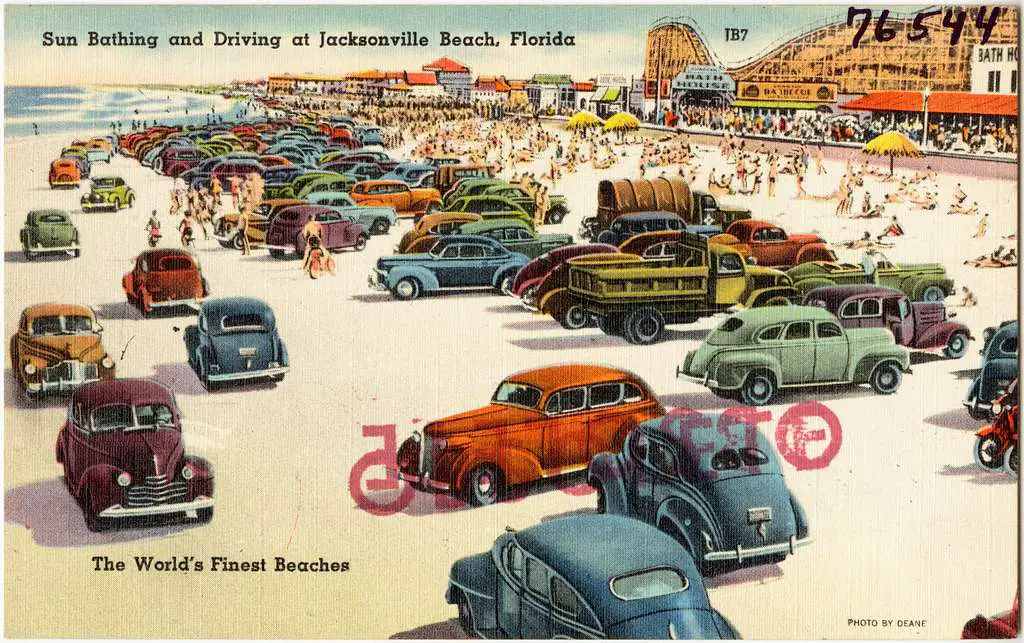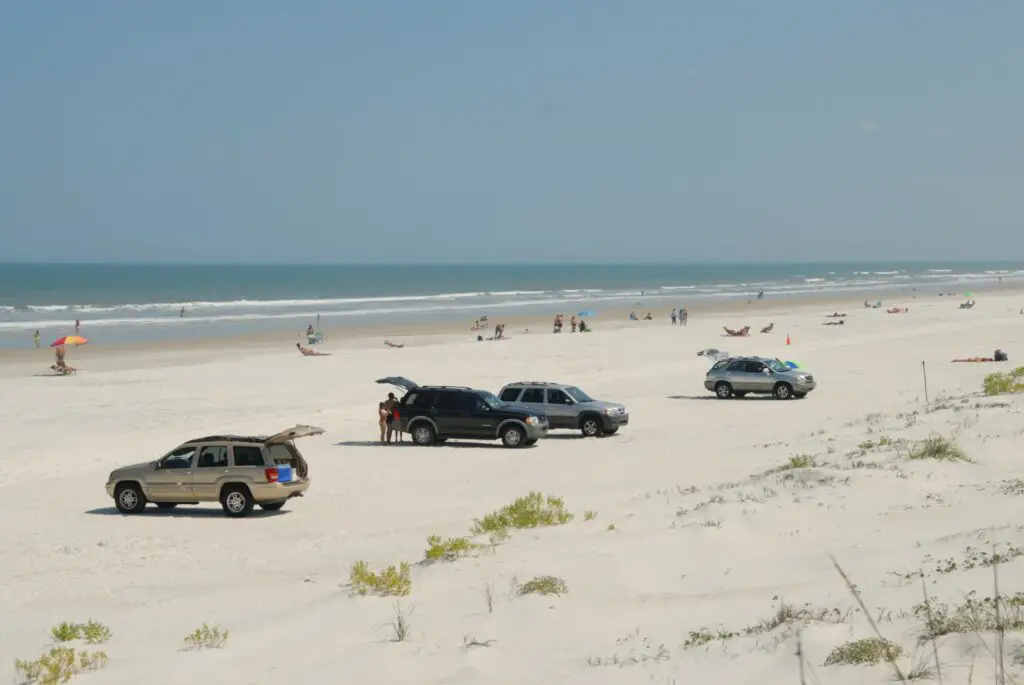Hey there beach lovers and adventure seekers!
Are you ready to hit the sandy shores of Florida for an unforgettable driving experience?
Look no further because we’ve got the ultimate guide to driving on Florida beaches right here! Buckle up, grab your shades, and let’s dive into the sun-soaked world of beach driving in the Sunshine State.
Driving on the Beach in Florida
Florida Beach Driving – A Unique Adventure

If you’ve never experienced the thrill of driving on a beach, Florida offers an incredible opportunity to do so.
Unlike the traditional road trip, beach driving gives you a chance to feel the gentle ocean breeze, listen to the waves crashing, and soak in the breathtaking coastal views, all while cruising in your vehicle.
It’s an adventure like no other, and with some helpful tips and tricks, you’ll be ready to make the most of it!
Know Before You Go

Before you rev up your engine and hit the beach, there are some essential things you need to know to ensure a smooth and enjoyable drive.
Let’s go over the crucial details:
Check Local Regulations
Each beach in Florida might have its own set of rules and regulations when it comes to beach driving.
Some beaches allow it year-round, while others have specific seasonal restrictions.
Make sure to check the local authorities or the beach’s website for up-to-date information about permitted driving areas, speed limits, and any necessary permits.
🏖Related post: 11 Best Spring Break Destinations in Florida for Families
Navigating the Permit Process
Driving on certain Florida beaches requires permits, so it’s crucial to know the rules and regulations of each area you plan to visit.
Check the official website of the beach you’re heading to, or contact local authorities to understand the permit requirements and any restrictions in place.
Additionally, consider the time of year, as some beaches may have seasonal restrictions to protect nesting wildlife.
🏕️ Related post: Best Campgrounds in Florida Keys with Cabins
Timing is Everything: The Best Time to Cruise the Beaches
Avoiding crowds and making the most of your beach-driving adventure comes down to timing.
Aim for early mornings or late afternoons when the beaches are less crowded, the temperatures are cooler, and you might even catch a breathtaking sunrise or sunset.
Plus, driving on cooler sand can be easier on your vehicle.
Unwind and Relax: Beachside Camping
Extend your beach-driving adventure by spending the night under the stars. Several Florida beaches offer camping options, allowing you to wake up to the soothing sound of crashing waves.
Whether you prefer the convenience of RV camping or the simplicity of setting up a tent, beachside camping is a delightful way to fully immerse yourself in the natural beauty of the Sunshine State.
🚐 Relevant post: Your Guide to the Best Private Campgrounds in Florida for 2023
⛺️ Relevant post: Is Florida Good for Camping? Pros & Cons to Help You Decide!
Choose the Right Vehicle
When it comes to beach driving, not all vehicles are created equal. Choosing the right vehicle can make a world of difference in your driving experience on the sandy shores of Florida.
Here are some essential considerations to keep in mind when selecting the perfect ride for your beach adventure:
Four-Wheel Drive (4×4) or All-Wheel Drive (AWD)
Having a vehicle with four-wheel drive or all-wheel drive is a game-changer for beach driving.
These drivetrains provide power to all four wheels simultaneously, increasing traction and stability on loose and uneven surfaces like sand.
With all wheels working together, you’ll have a better chance of maintaining control and avoiding getting stuck.
Ground Clearance
Ground clearance is the distance between the lowest part of your vehicle (usually the undercarriage) and the ground.
A vehicle with higher ground clearance is better suited for beach driving because it reduces the risk of your car’s underbelly scraping against the sand.
It also allows you to tackle small obstacles like ruts and mounds more easily.
Off-Road Features
Some vehicles come with specific off-road features that enhance their performance on challenging terrains.
Look for features like off-road tires, skid plates, and electronic traction control systems.
These features can boost your vehicle’s off-road capabilities and increase your confidence while beach driving.
Size and Weight
In general, larger and heavier vehicles tend to fare better on the beach. Their added weight helps them sink less into the sand, providing better traction.
However, this doesn’t mean you need a massive truck or SUV. Many mid-size SUVs and even some crossovers can handle beach driving quite well.
Vehicle Condition
Before hitting the beach, ensure your vehicle is in good working condition. Beach driving can put additional strain on your car, so it’s crucial to have it serviced and checked for any mechanical issues.
Make sure your tires are properly inflated, and all fluids are at their recommended levels.
Mind the Saltwater
Remember that driving on the beach exposes your vehicle to salt water, which can accelerate corrosion.
Rinse off your vehicle thoroughly after beach driving to remove any salt and sand.
Also, consider applying a protective coating to help shield your car’s undercarriage from saltwater damage.
Rental Options
If you don’t own a suitable vehicle for beach driving, don’t worry! Florida has several places where you can rent off-road vehicles or Jeeps specifically designed for beach adventures.
Renting a vehicle can be a cost-effective option, especially if you plan to enjoy beach driving only for a short period.
By choosing the right vehicle for beach driving, you’ll be setting yourself up for an amazing and trouble-free experience.
Remember to prioritize safety, respect the beach environment, and follow local regulations for beach driving to ensure everyone can continue to enjoy these beautiful sandy stretches for years to come.
Top Beach Driving Destinations in Florida
Florida boasts an array of stunning beaches where you can drive to your heart’s content. Let’s explore some of the top destinations for beach driving:
Daytona Beach
Daytona Beach, known for its iconic Daytona International Speedway, also offers 23 miles of hard-packed sand perfect for beach driving.
From sunrise to sunset, you can cruise along the shoreline, park your vehicle, and enjoy a beachfront picnic or take a refreshing dip in the Atlantic Ocean.
ℹ️ Useful link – https://www.daytonabeach.com/things-to-do/beaches/driving-on-the-beach/
Cape San Blas
Located on Florida’s Panhandle, Cape San Blas is a hidden gem for beach driving enthusiasts.
With its soft, sugar-white sands and crystal-clear waters, you can explore this unspoiled paradise by driving right along the water’s edge.
🏖 Relevant post: St. George Island vs Cape San Blas: An Honest Comparison to Help You Choose!
Amelia Island
Amelia Island provides a more tranquil beach driving experience. It’s a fantastic spot for birdwatching, shelling, and catching stunning sunsets while cruising in your vehicle.
Remember to stay off the dunes and be on the lookout for nesting sea turtles!
🏖 Relevant post: 9 Best Weekend Getaways in Florida for Couples
🏖 Relevant post: Sanibel Island Vs. Anna Maria Island: Which is BETTER for Vacation?
Tips for a Safe and Enjoyable Beach Driving Experience
To make the most of your beach driving adventure, follow these tips to ensure a safe and enjoyable experience:
Check Tide Times
Tides can significantly impact your beach driving experience. Low tide provides more extensive driving areas with firmer sand, making it easier to navigate.
Avoid driving during high tide, as the soft sand near the water can be challenging to maneuver.
Reduce Tire Pressure
Lowering your tire pressure can improve traction on sandy surfaces, reducing the risk of getting stuck.
However, be sure not to overdo it—moderate deflation is usually sufficient (around 20 psi).
Stay Away from Water
Driving too close to the water can be risky, especially if you’re unaware of sudden waves or changes in the tide.
Aim to maintain a safe distance from the waterline to prevent your vehicle from getting caught in the waves.
Pack the Essentials
Be prepared for a day at the beach. Bring along essentials like water, snacks, sunscreen, and a first-aid kit.
You might also want to pack a shovel, tow rope, and a jack, just in case you encounter any minor mishaps.
Beach Driving Etiquette
Just like any other adventure, beach driving comes with its own set of etiquettes. Let’s go over some essential beach driving manners:
Respect Marked Zones
Pay attention to any marked driving zones and stick to them. These areas are designated to protect fragile ecosystems and wildlife habitats.
Keep It Clean
Take all your trash with you when you leave the beach. Keep in mind that the pristine beauty of the shoreline should be preserved for everyone’s enjoyment.
Be Mindful of Others
Watch out for beachgoers, sunbathers, and pedestrians. Drive at a safe speed and always be considerate of others’ space and safety.
Wrapping Up
Now that you’re armed with the ultimate guide to driving on Florida beaches, it’s time to rev up your engine and embark on an unforgettable adventure!
From the vibrant shores of Daytona Beach to the serene beauty of Cape San Blas, Florida offers a diverse range of beach driving experiences.
Remember to check local regulations, respect the environment, and follow safety tips for a smooth and enjoyable drive.
So, what are you waiting for?
Grab your beach gear, hit the coast, and let the salty air and sandy shores whisk you away on an epic beach-driving journey through the Sunshine State!
Happy beach driving! 🏖️🚗